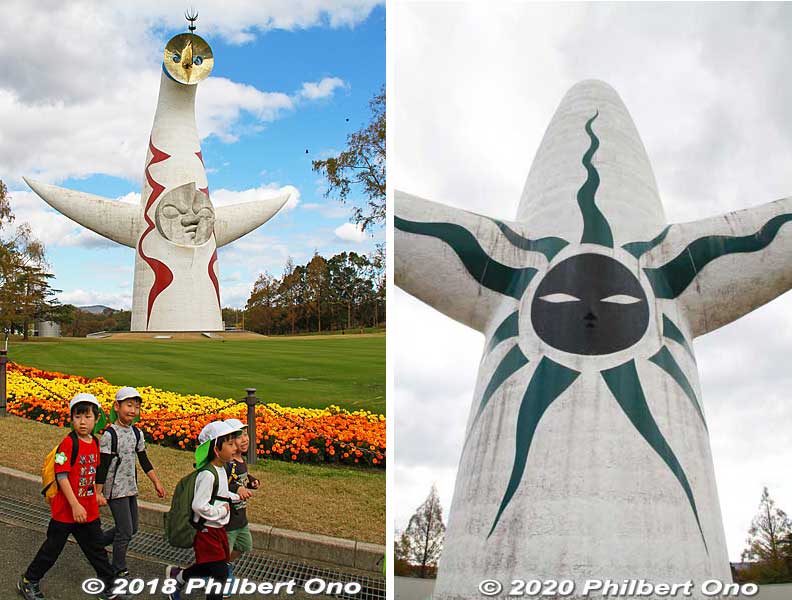
Over half a century ago in 1970, Japan held the biggest and grandest world exposition the world had ever seen. It was Expo ’70 in Suita, Osaka from March to September. With 116 pavilions, 76 participating countries, and a record 64 million visitors, the expo was enormous and hugely popular. One of Japan’s major postwar milestones on the heels of the 1964 Tokyo Olympics.
The pavilions featured innovative and fantastical designs with lots of futurism and fantasy. The US Pavilion was super popular with a small moon rock brought back from the moon just a year earlier. Japan’s massive pavilion was shaped like a cherry blossom, just like the expo’s iconic sakura logo. The expo was massively crowded, especially during the muggy, hot summer when snaking lines of people had to doggedly wait hours to enter the popular pavilions.
Expo ’70 pavilions: https://www.expo70-park.jp/languages/english/expo70/
Expo ’70’s iconic symbol and focal point was this giant, eternally unforgettable sculpture named “Tower of the Sun” (Taiyo no To 太陽の塔) created by famed sculptor Okamoto Taro (岡本太郎 1911–1996). It’s one of the few remnants of Expo ’70 still standing and one of Japan’s most famous outdoor sculptures (probably one of the Top Three along with Kamakura’s Great Buddha and the Nagasaki Peace Statue).
At first glance, you may think, “What the heck is it??” Looks like a bird, but it’s not a bird. Whatever it is, it looks awesome and it permanently solidified Okamoto’s fame and mad genius. Anybody seeing it for the first time can’t help but to distinctly remember it for the rest of his or her life.
Tower of the Sun has three faces of the sun. On the top is a gold face representing the future. During the Expo in the evenings, this face’s eyes emitted a blue beam across the expo site. Simply awesome. The second face is on the tower’s midsection, a sculptured, mashed face representing the present. This face is accented with red lightning bolts on both sides. The third face is painted on the back of the Tower (right photo), representing the past as it looks back.
This magnificent edifice was originally intended to be temporary and was scheduled to be demolished after the expo. Fortunately, a successful petition to preserve it led to a decision in 1975 to preserve it permanently. It has since become another iconic symbol of Osaka and the most visible symbol and legacy of Expo ’70.
Until recently, it was little known that this famous Tower of the Sun was hollow and also had an indoor exhibit. During the Expo, the public could actually enter the Tower to see Okamoto’s other massive sculpture named, “Tree of Life” (Seimei no Ki 生命の樹). This indoor exhibit closed after the Expo, but finally reopened in March 2018 for guided tours after the “Tree of Life” was painstakingly restored and the Tower reinforced against earthquakes (interior walls were thickened). They did an amazing job.
The Tree of Life inside the Tower is a towering (41 meters high) artificial tree made of steel with branches decorated with diverse species. They show the evolution of life on Earth. It starts with amoeba on the tree’s roots and ends with primates (gorilla) and Neanderthals on the top tree branches. In-between are plants, crustaceans, and even huge dinosaurs (brontosaurus and T-Rex). There’s a staircase going around the tree so you can see the entire tree. Just so in.cre.di.ble. You can also see inside the Tower’s two empty, pointy wings.
I highly recommend touring the inside of the Tower. The entrance is at the back of the Tower at the bottom, below the painted face representing the past. Advance ticket reservations are required at least one day in advance. Admission for adults is ¥720.
Tower of the Sun: https://taiyounotou-expo70.jp/en/
After Expo ’70 was dismantled, the huge site was converted into a park. It now has a few major museums, Japanese garden, amusement park, and shopping mall. Be sure to visit the Expo ’70 Pavilion in the building that used to be the Steel Pavilion during Expo ’70. It has great exhibits about Expo ’70.
Also, visit the National Museum of Ethnology showcasing cultures of the world. For shopping or dining, go to the nearby Expo City shopping mall. Lots to do before and/or after your visit to the Tower of the Sun. The Tokyo 2020 Olympic Torch Relay was also held in this park after it was taken off Osaka’s public roads. A pleasant run for sure.
Expo ’70 Pavilion: https://www.expo70-park.jp/languages/english/facilities/#caption2
National Museum of Ethnology: https://www.minpaku.ac.jp/en
After Expo ’70, Japan held three more world expos (Expo ’75 in Okinawa, Expo ’85 in Tsukuba, and Expo 2005 in Aichi). None surpassed the grandeur and popularity of Expo ’70. Another one is slated for 2025, again in Osaka. Expo 2025 just recently selected its official logo, a weird-looking red donut ring with eyes. One of the weirdest expo logos in history, but receiving much PR as a result. Looking forward to it too. ![]()
Expo 2025: https://www.expo2025.or.jp/en/
![]() Closest train station is Banpaku-Kinen-Koen Station on the Osaka Monorail. From Osaka/Umeda Station, take the Midosuji Subway Line to Senri-Chuo Station where you transfer to the Osaka Monorail.
Closest train station is Banpaku-Kinen-Koen Station on the Osaka Monorail. From Osaka/Umeda Station, take the Midosuji Subway Line to Senri-Chuo Station where you transfer to the Osaka Monorail.